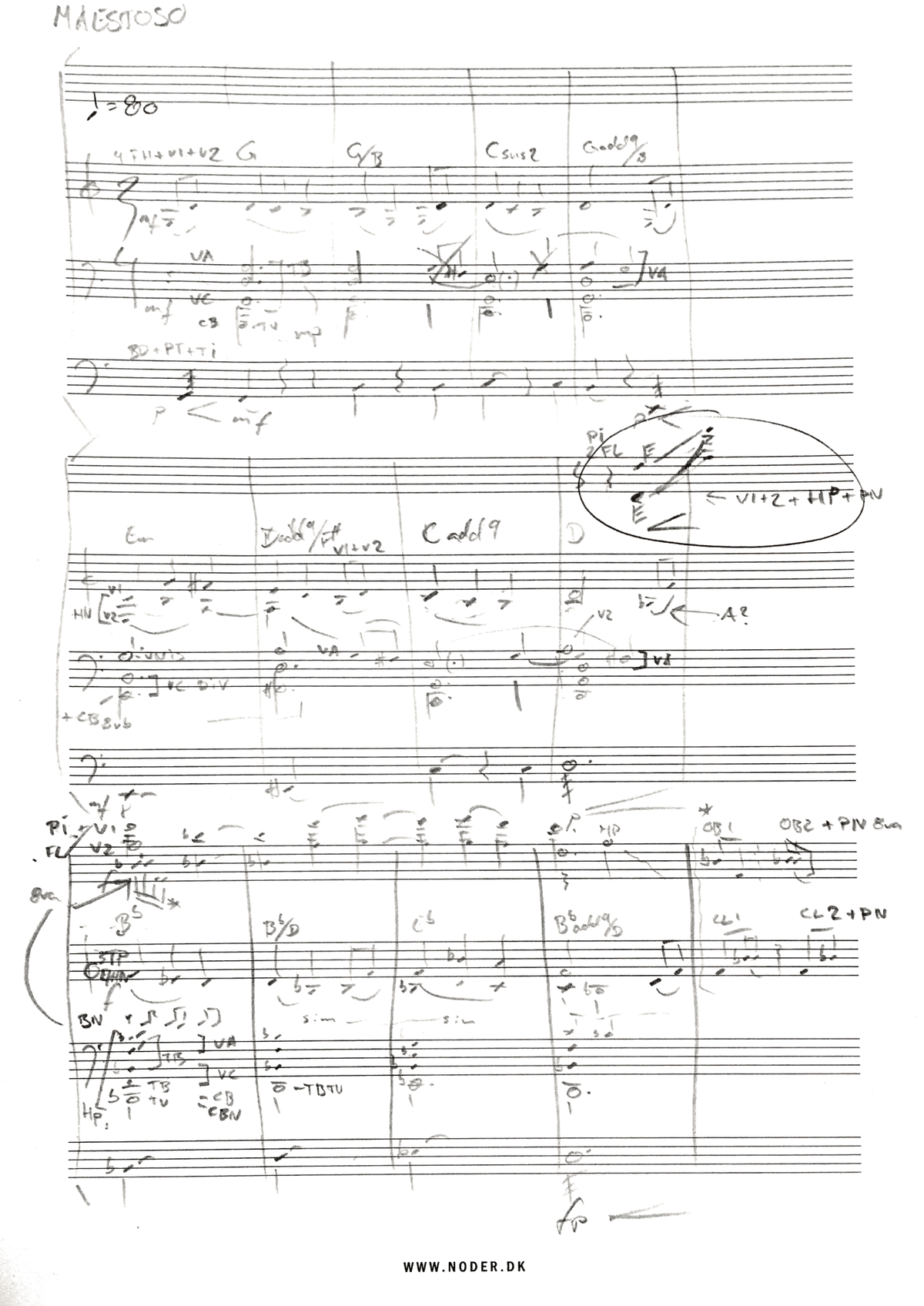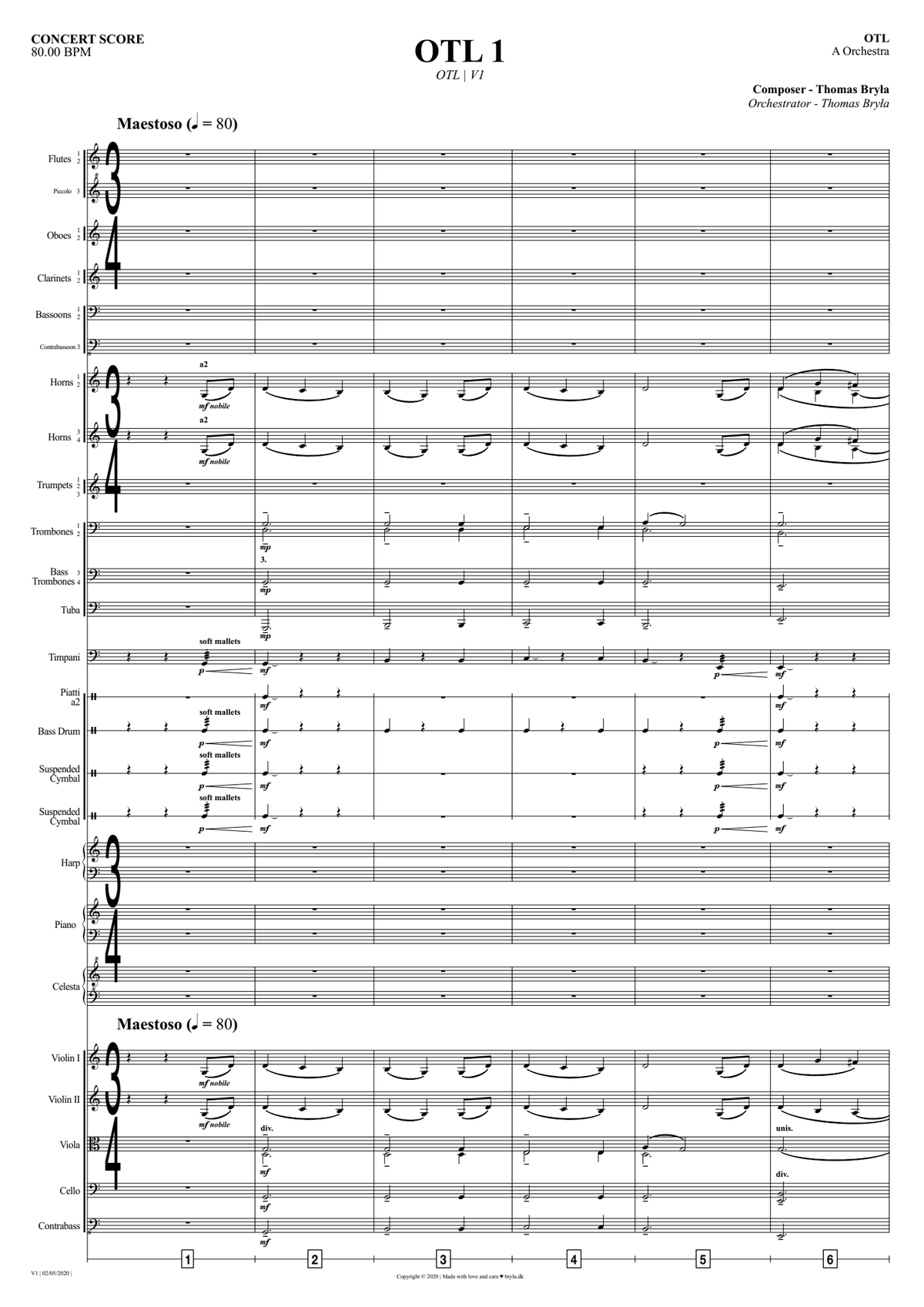bryla
Orchestrator
Been taking the ScoreClub courses during lockdown and I have been trying some of Alain's concepts.
Started with this short score:

Turned it in to this rough mock-up:

Put it in to Sibelius:

And here's the Noteperformer:

My process as described on Scoreclub:
First of all the concept of writing in the four staves is new to me, so it's much clear now how the line is shaped, what's background, resonance and 'overtones'.
If I try to take it line by line:
First line it is clear how the background doesn't have any overlap with the melody except once and the voicing is clear according to the overtones.
Both the accompanying chords and the percussion marks the slurring of the melody. In the mock-up I later decided to withhold many of the piatti crashes but bass drum and timpani still do.
Second line I used thickening to increase the melody. What my feeble attempt in the first mock-up didn't show was then how the scale run connects the melody note in bar 8 to the counter line in bar 9.
Bar 9 is to me where the magic of OTL started. I did the chord voicings in trombones, tuba. Doubled them in violas, cellos, basses and contrabassoon. As long as these voicing support the melody with no overlap I could then build motion on the overtones in the background. First off you see in bar 9 I've marked BN for bassoons and followed by an eight note rhythm. (I tried to make pointy lines to show that the rhythm applied to the topmost Bb and F of the chord). So bassoons are now making motion to the violas.
In the top staff of bar 9 I have a beautiful arrow pointing at some sixteenths. They are connect to the bassoon (meaning the violas actually) and are over tones of those notes. They play the sixteenth figure that I specified orchestrationally rightmost on the page with overlap between the clarinets and oboes (I see now that I forgot to double piano on these in the mock-up which would add more overtones).
This texture continues for 8 bars so please move along
Then for the closing melody it was a minor version of the original. As the opening metaphor was Maestoso this could be Delicate.
Piano and Celeste on the melody with glock, triangle and celeste 8va doubling simply the first note of each bar for an accent (now I was getting more aware of the shaping).
Same procedure with laying out the chords with no overlap and picking a delicate texture: tremolo strings and harp/piano on broken chords.
Last four bars was then a tutti development of this. Going back still to laying out the initial chords with no overlap I took the top three notes of the chord and made an overtone version of them as moving arpeggiating triplets. Then I ran in to the problem that if I had three downward arpeggios from G D Bb in a row, they would collide with the F in the melody. I simply decided to have the first note of each triplet be the melody note, which then helped shape the line.
Now what is in that staff alone I transposed an octave up for the flutes, the original I kept in oboes and moved it an octave down to the clarinets so they actually sit on top of the original chord making a motion to that. Doing the mock-up I forgot about the asterisk
In hindsight I have not been careful with dynamic markings before moving on but that's something I've gotta learn.
Thank you for asking for an explanation. Writing this post made me think about it in yet a different light and I hope it sheds some light as well
Started with this short score:
Turned it in to this rough mock-up:
Put it in to Sibelius:
And here's the Noteperformer:
My process as described on Scoreclub:
First of all the concept of writing in the four staves is new to me, so it's much clear now how the line is shaped, what's background, resonance and 'overtones'.
If I try to take it line by line:
First line it is clear how the background doesn't have any overlap with the melody except once and the voicing is clear according to the overtones.
Both the accompanying chords and the percussion marks the slurring of the melody. In the mock-up I later decided to withhold many of the piatti crashes but bass drum and timpani still do.
Second line I used thickening to increase the melody. What my feeble attempt in the first mock-up didn't show was then how the scale run connects the melody note in bar 8 to the counter line in bar 9.
Bar 9 is to me where the magic of OTL started. I did the chord voicings in trombones, tuba. Doubled them in violas, cellos, basses and contrabassoon. As long as these voicing support the melody with no overlap I could then build motion on the overtones in the background. First off you see in bar 9 I've marked BN for bassoons and followed by an eight note rhythm. (I tried to make pointy lines to show that the rhythm applied to the topmost Bb and F of the chord). So bassoons are now making motion to the violas.
In the top staff of bar 9 I have a beautiful arrow pointing at some sixteenths. They are connect to the bassoon (meaning the violas actually) and are over tones of those notes. They play the sixteenth figure that I specified orchestrationally rightmost on the page with overlap between the clarinets and oboes (I see now that I forgot to double piano on these in the mock-up which would add more overtones).
This texture continues for 8 bars so please move along
Then for the closing melody it was a minor version of the original. As the opening metaphor was Maestoso this could be Delicate.
Piano and Celeste on the melody with glock, triangle and celeste 8va doubling simply the first note of each bar for an accent (now I was getting more aware of the shaping).
Same procedure with laying out the chords with no overlap and picking a delicate texture: tremolo strings and harp/piano on broken chords.
Last four bars was then a tutti development of this. Going back still to laying out the initial chords with no overlap I took the top three notes of the chord and made an overtone version of them as moving arpeggiating triplets. Then I ran in to the problem that if I had three downward arpeggios from G D Bb in a row, they would collide with the F in the melody. I simply decided to have the first note of each triplet be the melody note, which then helped shape the line.
Now what is in that staff alone I transposed an octave up for the flutes, the original I kept in oboes and moved it an octave down to the clarinets so they actually sit on top of the original chord making a motion to that. Doing the mock-up I forgot about the asterisk
In hindsight I have not been careful with dynamic markings before moving on but that's something I've gotta learn.
Thank you for asking for an explanation. Writing this post made me think about it in yet a different light and I hope it sheds some light as well
Last edited:





